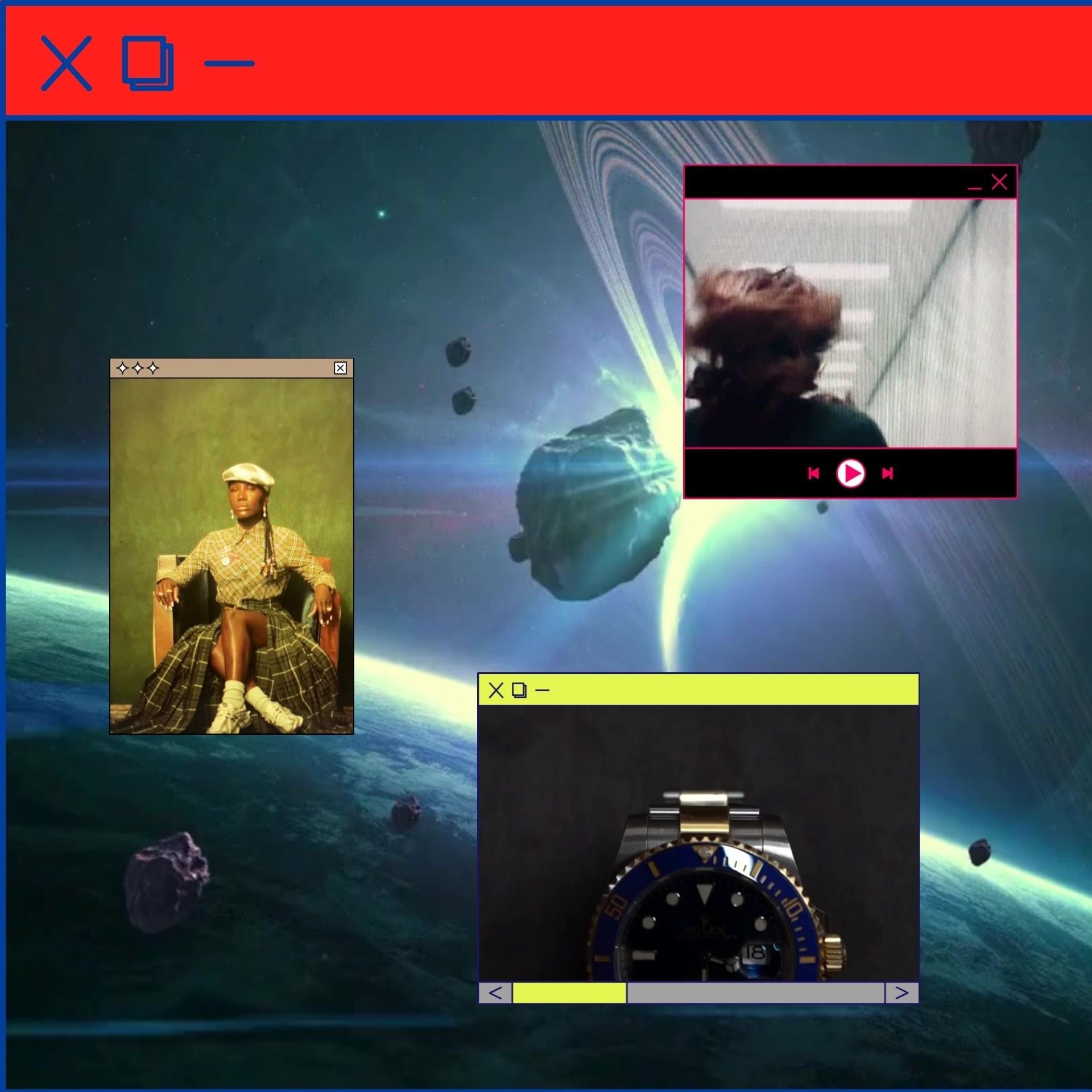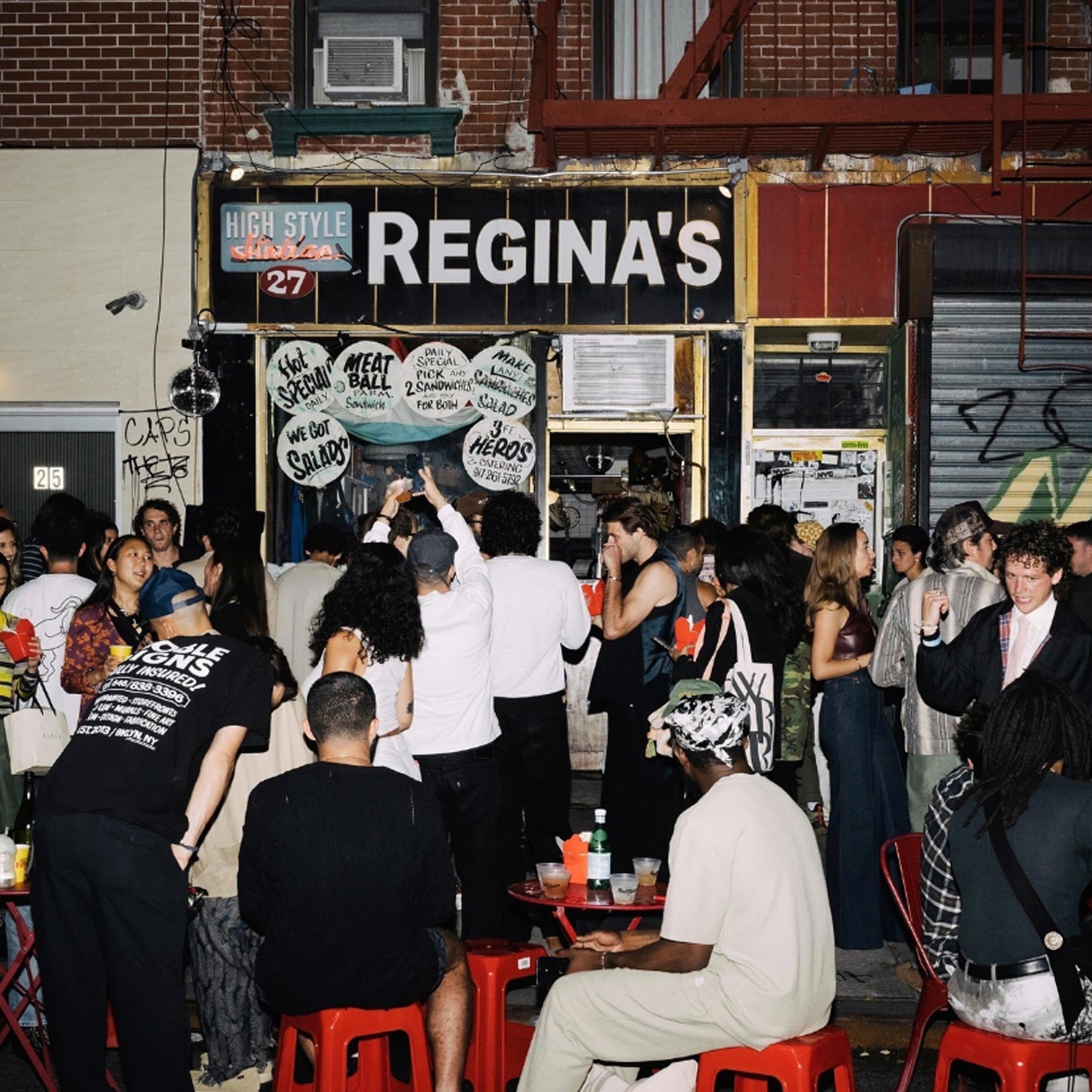

BUILDING COMMUNITY IN A HYBRID WEB 2/3 WORLD
Brands that can successfully navigate an on-chain (blockchain) and off-chain (traditional) marketing model are poised to reap the rewards of more meaningful customer loyalty, and deeper connections—unlocking new avenues for personalization, and ultimately, greater brand success.
To fully embrace this paradigm shift, it’s time we say goodbye to the funnel and hello to crafting personalized customer journeys into hybrid communities. Leveraging blockchain-based tech to create decentralized and community-driven platforms, brands can foster deeper connections with their customers and build trust through shared values and experiences.
Last year, the founder of Far From Timid–a Web2/3/IRL brand and social commerce agency, and my editor, Alona–traveled across the country delivering a talk about how brands can make the most of dipping their toes into the metaverse and Web 3. One year later, we wanted to revisit the tactics. We’ll delve into the key strategies that brands can use to build hybrid communities and the short-term and long-term wins you’ll want to get started on today.
How Did We Get Here and What Can You Do to Keep Up?
Gen Z is a passionate generation, where 73% want brands to care about values like diversity, inclusion, and most importantly, sustainability.1
Throughout the last decade and beyond, much of social media has had a steady and often toxic relationship with vanity. But there’s been a shift—Gen Z has grown up chronically online and they can see through the facade of curated perfection.

©Far From Timid
Gone are the days of curated Instagram feeds and Pinterest boards, vanity, and an unhealthy reliance on aesthetics alone. Superficial metrics—Likes—have acted as the primary builder of one’s identity—think curated Instagram feeds, camera rolls of hundreds of takes, and Facetuning the best image for a single post. For the last decade or more, much of social media has leaned on these one-dimensional markers of popularity, but for Gen Z, authenticity trumps vanity. Gen Z is posting photo dumps that seem designed to look bad2, brands like Slim Jim post cryptic memes about joining the “long boi gang” to their 1.4M (and counting) followers, and brands are releasing collections that look pre-used, like Balenciaga’s $5,600 denim jacket that looks dirty and destroyed, complementing their Summer 2023 theme of “The Mud Show”. Distressed denim aside, brands are leaning towards less perfection and instead embracing the authentic truth that life isn’t always perfect.
Belonging, authenticity, and entertainment are key factors that shape Gen Z’s expectations from brands. Truly effective hybrid communities utilize a delicate mix of traditional Web2 marketing, Web3 marketing, and community-building tactics to engage with their audience. This approach allows brands to leverage the strengths of what we know and what is new, to drive growth for their brand and build community.
What is a Hybrid Community?
Brands can expand their presence from hosted platforms (Twitter, YouTube, Instagram, TikTok) where superficial interaction takes place, and drive audiences to more personalized and authentic interactions within Web3 communities–a digital Third Place acting as a refuge from the increasing amount of bots, fake news, and noise of the internet.
For example, a brand may use Web2 social media platforms like Facebook and Instagram to reach a wider audience and drive traffic to their Web3 community platform, where brands can deepen engagement and incentivize community participation by rewarding users with tokens, NFTs, POAPs (proof of attendance protocols) or other digital assets for contributing to the community.

©Far From Timid
During the most recent NFT.NYC, we connected with Mikey Piro, COO of Crypto Packaged Goods, a Web3-native community touting an incubator program, mentorship opportunities, and other exclusive benefits within their private token-gated networking group. When asked for his contact info, he brought out his NFC-enabled business card, using the “grown up” version of RFID tech—think of Apple Pay and “tap to pay” credit cards. Tapping this card brought us to the POAP app, where digital “Bookmarks for your life” are stored in the form of NFTs. It took mere seconds for a digital token to appear. “You met Mikey at NFT NYC 2023”, says my new POAP— #16, to be exact, along with links to learn more and even the ability to see a list of others that also met him during the event.
Utilizing NFC tech (near-field communication) to distribute information and/or digital assets is yet another way to bridge the digital and physical worlds. Combining these approaches, brands can create a more seamless and engaging user experience while tapping into the benefits of decentralized, blockchain-based technologies, resulting in greater user engagement, more meaningful interactions, and a stronger sense of community ownership and participation.
At NFT.NYC, we also met Jonathon Button, host of a few panels on the brand stage and a global Web3 strategist who spoke effusively about the Gmoney NFT community. We asked him what significant way it made a difference in his life—any job offers, marriage proposals? He quipped, “Don’t know about marriages coming from Gmoney, but definitely very strong friendships have come from it. The best moments are when you are already friends online (through Discord) and then you meet IRL as you are collecting the POAPs and you instantly hug it out. Lots of those special moments happened for me at NFT Paris and at NFT.NYC.”
Chris Dixon, a general partner at Andreessen Horowitz since 2012, believes Web3 is the future of the internet, and that communities and NFTs work well together. He shared that “I view the internet today as millions of subcommunities. I think NFTs are a way for subcommunities to have cultural artifacts and create little economies within them. It is a big world, so some of the popular existing ones will go awry, but my bet is that there will be many positive communities.”3
Your community is one of your most important assets as a brand to attract Gen Z, and we have a unique opportunity to connect in new, exciting, and unprecedented ways.
How Web2 + Web3 Communities Differ
Web3 community building emphasizes greater user/data ownership and communication, transparency, security, and community-driven decision-making, while traditional Web2 marketing and community-building tactics tout centralized control, focusing on data collection via things like cookies and targeted, demographics-based advertising.

Where early Web2 digital tactics involved driving people to a website, more mature Web3 tactics involve being where customers are, creating native campaigns and commerce opportunities directly on social channels that drive awareness and revenue—social commerce—driven by community building thus throwing out traditional funnel math and metrics. What worked in the past won’t work with Gen Z, a generation where 50% make social commerce purchases.4 Social Commerce is the future of retail and can be leveraged best in Web3.
Starbucks, for example, introduced its new blockchain-powered loyalty program, Starbucks Odyssey, as a place for community members to organize and hang out. These community members aren't sitting around all day talking about how much they love Starbucks coffee, though those conversations certainly occur—but Starbucks is giving them something much more valuable. Upon entering the Starbucks Odyssey Discord server, I am joined by a community of coffee lovers that are socializing, speculating, networking, and making friends inside a digital “Third Place” resembling the vibe of a coffee shop, volunteered and curated by Starbucks—all while introducing elements of digital rewards, ownership, and gamification. Community members are earning rewards that they can talk about, flaunt, buy, sell, and trade, all within this community. As Brady Brewer, Executive Vice President, and Chief Marketing Officer at Starbucks remarked, “The Starbucks Odyssey experience will extend the Third Place connection to the digital world.”5
Marriott International was one of the first hospitality brands to start leveraging NFTs and blockchain tech for their loyalty program, Marriott Bonvoy®.6 They partnered with digital artists during Miami Art Basel 2021 to release a travel-inspired NFT collection through their “The Power of Travel” campaign. Marriott Bonvoy hosted a giveaway during the event, where three individuals each won one of the exclusive NFTs as well as 200,000 Marriott Bonvoy points—bridging their existing loyalty program with blockchain-based loyalty tokens in the form of NFTs.
An organization named LinksDAO, sold over 9,000 memberships (totaling over $11 million) with a mission to build a real-world golf course, with virtual and in-person meetups for NFT holders within the digital-native country club along the way.7 The DAO (Decentralized Autonomous Organization) is powered by smart contracts and blockchain technology.8
These examples of LinksDAO and Marriott build upon the lens of community building, ownership, and decentralization which are paramount to Web3. Research from PwC states, “Among other things, Web3 introduces a true two-way channel with each customer. Companies have the opportunity to view brand advocates as partners rather than consumers or subscribers.”9
Redefining Identity + Ownership
Using centralized platforms like Facebook, Twitter, and LinkedIn means users are locked into their platform of choice with limited options for data ownership. Additionally, users’ identities are “owned” by these centralized platforms rather than by the individual user, and interoperability is often poor (because platforms don't want you to leave for somewhere else). Web3, on the other hand, urges users towards decentralized platforms and social graphs, such as Lens Protocol, Farcaster/Warpcast, and Bluesky–a recently launched Twitter alternative by Jack Dorsey.

Many of these open protocols and platforms rely on blockchain technology, which allows for user-owned and peer-to-peer networks. Federated networks are often utilized, with many platforms comparing themselves to email, but with enhanced privacy, security, and decentralization, which leads to a more seamless user experience and greater interoperability. In Web3, your wallet is your identity, which means you can take it wherever you please.
As the metaverse continually evolves to include more sophisticated and interoperable iterations of blockchain, marketing leaders that embrace this hybrid approach to community-building, loyalty, and analytics will be better positioned to succeed.
Understanding Blockchain-based Metrics
Web2 relies on metrics of engagement and reach, such as likes, shares, and followers, to measure success. In contrast, Web3 incorporates blockchain-based metrics such as token ownership and transaction history to measure community participation and value creation. For example, Starbucks Odyssey, for example, can measure the number of loyalty tokens redeemed for completing tasks, and even see if those tokens are then transferred or sold (either P2P or through a secondary market), which they can easily monitor thanks to blockchain explorers, which can be used as powerful analytics tools.

When it comes to NFTs and brands releasing digital collectibles, or even brands testing out the waters by utilizing aspects of blockchain technology, there are several key KPIs that marketers should know about. One of the most important metrics is the number of tokens minted. This is the Web2 equivalent of sign-ups or people joining the community. This is a key indicator of the interest in the NFT or digital collectible being released. Another KPI to keep an eye on is the time from initial mint to sell-out. Many NFT creators and brands hope to sell out as soon as possible after release. This metric is similar to measuring how quickly a product sells out in a traditional retail setting. Money isn’t everything in the space, but at the same time, you can’t ignore price entirely; floor price movement and average sales price are also important metrics to consider. Floor price movement refers to the minimum price at which a particular NFT or digital collectible is being sold, while the average sales price provides a broader view of the market as a whole. These metrics can provide insights into how the market is evolving and what the perceived value of different NFTs and digital assets is.
There’s always been a marketer's dilemma when it comes to measuring ROI. It is notoriously difficult to determine what’s working and what’s actually driving conversion. But Web3 will solve some of these problems as the tech can help marketers tell the full story to prove attribution.
Loyalty is Crucial for Web3 Success
A good way to track loyalty is by measuring the average hold time for your digital assets. This metric shows how many long-term holders the NFT or digital collectible has, and how many people are holding onto it rather than selling it right away. This can be an indicator of the perceived value of the NFT or digital collectible in the community. Measuring the amount of active community members is also paramount to success. Active community members are those who engage in discussions, participate in events (whether online or IRL), or in the case of a DAO or other token-gated organization, members that actively vote on issues that matter to them. All of these factors can be strong indicators of community engagement and involvement, which is a piece of the loyalty puzzle.

Loyalty can also be measured within a community utilizing a hybrid Web2/3 approach. Looking at active users that chat and hang out, sign up for mailing lists, or even what members consistently redeem perks, enter giveaways, or otherwise interact with their community can all give valuable insights that will allow you to measure your success, engagement, and level of community loyalty. Considering 40 percent of Gen Z believe brands should make them feel valued,10 it’s important to make your online community feel special.
Embracing Personalization Helps Foster Meaningful Connections
Web3 communities offer users greater control over their digital identities and data, allowing them to tailor their online experience and connect with like-minded individuals, encouraging a more intimate and personalized community experience.
Unique markers of digital identities, such as NFT PFPs, serve as powerful symbols of individuality and ownership within these communities, like in the case of Bored Ape Yacht Club, CryptoPunks, Azuki, Doodles, DeGods, or other notable NFT collections. Verification methods, like hexagon-shaped profile photos on Twitter, not only signify ownership but also help members identify each other. In Web3, NFTs, wallet activity, ENS domain names, and token holdings can paint a clear picture of a user's on-chain digital persona—and brands can use this valuable information to reward and delight new users entering their digital spaces in a more personalized way.

Unlike in Web2 communities, revenue models in Web3 are more equitable and encourage active community participation. Community members want to feel like they are part of something larger than themselves, and Web3 communities offer this through co-ownership and co-creation. Users can monetize their contributions directly through token rewards, which actively incentivizes participation, helping to distribute wealth more equitably within these communities. Web3 communities, especially DAOs (Decentralized Autonomous Organizations), which are usually token-gated or NFT-gated, allow users to have a direct say in a project's direction. Participation is rewarded and encouraged through things like offering up token rewards on DAO “bounty boards”. This system drives growth and development, all while rewarding those contributing to the organization.
Web3 communities offer a more intimate and connected experience, allowing users to take autonomy and ownership over their digital identities and participate actively in the growth and development of the communities they care about the most.
Community managers have pivoted into being one of the most crucial first hires for anyone looking to expand their presence into Web3. Community members want to feel like they are a part of something larger than themselves, and that their voice is being heard. Communities need leaders, liaisons, and educators in order to thrive. Web3 allows for a transformation from passive consumers to active community members. Often, community members describe feeling more like board members and in some cases, partial owners. This co-ownership and co-creation is a unique benefit stemming from so many Web3 communities.
We are Entering a New Era of Community-centered Marketing
Nowadays, it’s important for brands to look at marketing through the lens of hybrid models. For example, looking at digital wallet-based KPIs alongside email signups can allow you to provide even more exclusive perks thanks to embracing the hybrid world we live in now. This new data provided to us from Web3 tools and platforms become more valuable when compared to traditional “Web2” data. This hybrid space is where we will be for years, so a feedback loop from Web2 to Web3 KPI’s will strengthen every part of your business.
By understanding the strengths of both traditional and blockchain, marketers can better understand how to effectively use both Web2 and Web3 technologies together to reach their goals and maximize ROI. By adopting a hybrid approach to community building, brands can use blockchain tech to create communities that are more engaged and loyal, delivering more value to brands and their customers.
Far From Timid is a brand experience and social commerce agency. We're helping Web 2 brands stay relevant and keeping Web 3 brands honest with meaningful brand experience, expression, and NFT activations. We'd love to hear from you!
References
-
Edelman, A., & Hagelgans, A. (2022, December 7). Gen Z's voting Habits are all the Proof Companies Need to Act on Societal Issues. Fortune. Retrieved from https://fortune.com/2022/12/07/gen-z-voting-habits-proof-societal-issues-abortion-gun-climate-culture-politics-values-edelman-hagelgans/
-
Sinha, A. (2022, December 1). What's in an Instagram Photo Dump? Vogue. Retrieved from https://www.vogue.com/article/instagram-photo-dump-generation-z
-
Patel, N. (2022, April 12). Chris Dixon Thinks Web3 is the Future of the Internet - is it? The Verge. Retrieved from https://www.theverge.com/23020727/decoder-chris-dixon-web3-crypto-a16z-vc-silicon-valley-investing-podcast-interview
-
Kastenholz, C. (2022, November 9). Council post: Gen Z And The Rise Of Social Commerce. Forbes. Retrieved from https://www.forbes.com/sites/forbesagencycouncil/2021/05/17/gen-z-and-the-rise-of-social-commerce/?sh=1ad36b87251d
-
Starbucks. (2022, September 12). Starbucks Brewing Revolutionary Web3 Experience for its Starbucks Rewards Members. ********Starbucks Stories. Retrieved from https://stories.starbucks.com/press/2022/starbucks-brewing-revolutionary-web3-experience-for-its-starbucks-rewards-members/
-
Marriott International. (2021, December 4). Marriott Bonvoy Logs into the Metaverse with Debut of Travel-Inspired NFTs. Marriott International Newscenter (US). Retrieved from https://news.marriott.com/news/2021/12/04/marriott-bonvoy-logs-into-the-metaverse-with-debut-of-travel-inspired-nfts
-
LinksDAO. LinksDAO. (n.d.). Retrieved from https://linksdao.io/
-
Shuttleworth, D. (2021, October 7). What Is A DAO And How Do They Work? ConsenSys. Retrieved from https://consensys.net/blog/blockchain-explained/what-is-a-dao-and-how-do-they-work/
-
Oiver, J., Blumenfeld, M., Panjwani, V., & Likens, S. (n.d.). Demystifying web3: What does web3 mean for your business? PwC. Retrieved April 24, 2023, from https://www.pwc.com/us/en/tech-effect/emerging-tech/what-is-web3.html
-
Morris, T., Buckle, C., & Mander, J. (2021). Gen Z: Observing the latest trends on Gen Zs, AUDIENCE REPORT 2020. Global Web Index. Retrieved from https://www.gwi.com/hubfs/Downloads/Global Trends Among Gen Z - Snap Inc..pdf?_hsenc=p2ANqtz-8pcrnccd_-9GyKTwupq7j9AQpT3ikiNNWxp5GLeJP5x-woi0YmElTmwZj84wAD0DS8rGtqCuHTodyjkncvn6zr5B_9sg&_hsmi=73458189



